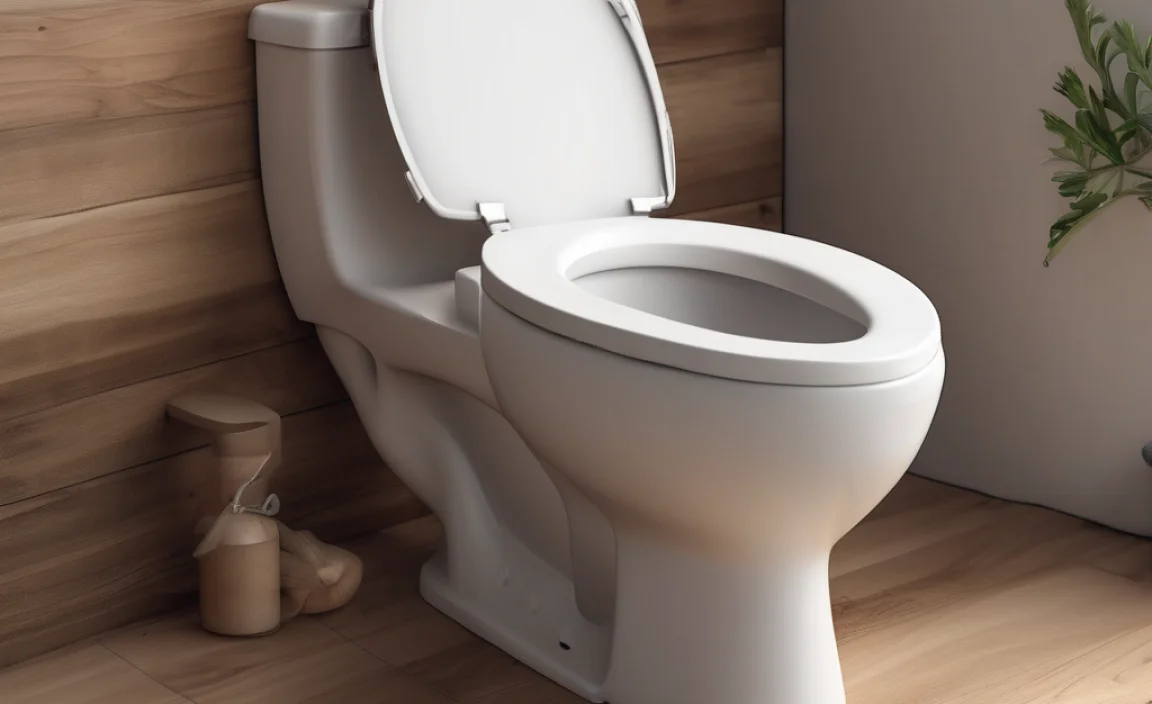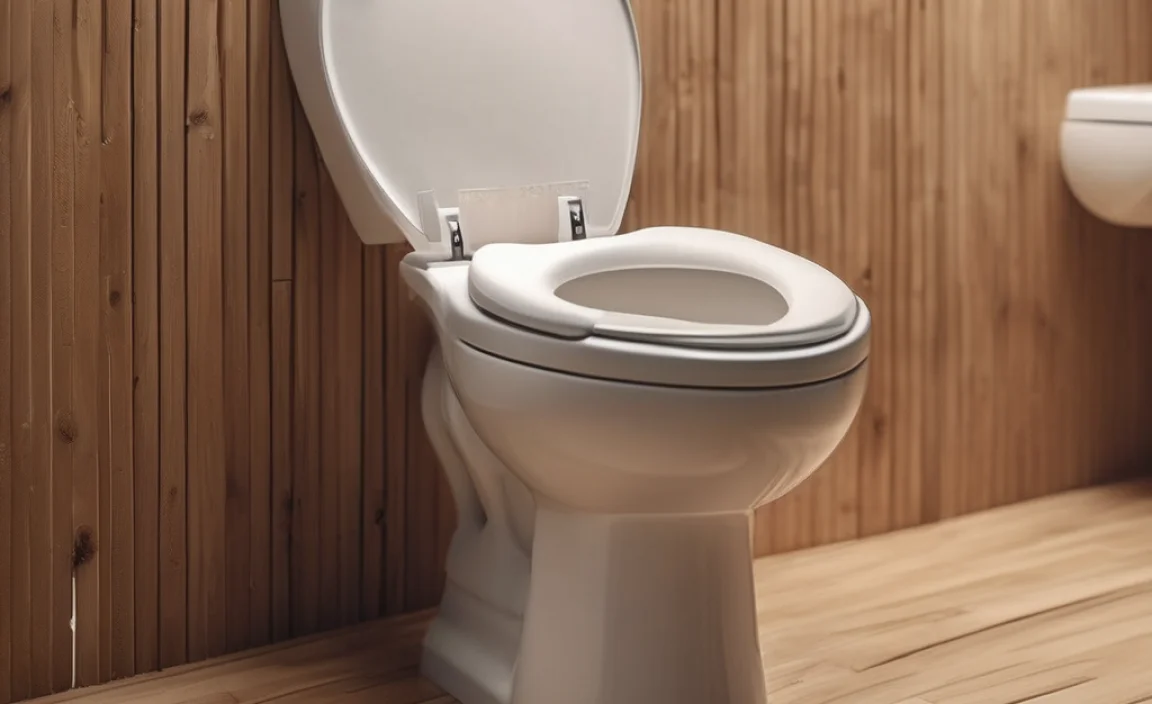Quick Summary: Yes, wooden toilet seats can be hygienic if cleaned properly and regularly. Wood itself has natural antimicrobial properties, but it’s essential to maintain a cleaning routine to prevent bacteria buildup. Choose sealed or coated wood seats, clean them often with mild soap and water, and disinfect regularly to keep them safe and sanitary.
Thinking about getting a wooden toilet seat? Great choice! They add a touch of class to any bathroom. But, you might be wondering if they’re as clean as those plastic ones. It’s a common question, and lots of folks worry about germs. No sweat! Keeping a wooden toilet seat clean is easier than you think. Follow along, and I’ll show you how to keep your bathroom stylish and germ-free. Ready to get started?
Understanding Wooden Toilet Seats and Hygiene

When it comes to bathroom fixtures, hygiene is a top priority. Wooden toilet seats have been used for ages, but are they really hygienic? Let’s dive into the details.
The Natural Properties of Wood
Wood has some cool natural properties that help keep things clean. Here’s a quick look:
- Antimicrobial Qualities: Some types of wood contain natural compounds that fight off bacteria.
- Porosity: Wood is porous, which means it can absorb moisture. This can be a downside if the wood isn’t sealed properly, as it can trap bacteria.
- Durability: High-quality wooden seats are durable and can last a long time if cared for properly.
But remember, even with these natural benefits, regular cleaning is still super important!
Sealed vs. Unsealed Wood
The type of wood and how it’s treated makes a big difference. Here’s what you should know:
- Sealed Wood: Most modern wooden toilet seats come with a sealant. This creates a protective layer that prevents moisture and bacteria from getting into the wood.
- Unsealed Wood: Unsealed wood is more prone to absorbing moisture and harboring bacteria. These are less common but require extra care.
Always go for sealed wood to make cleaning easier and keep things more hygienic.
Cleaning Your Wooden Toilet Seat: A Step-by-Step Guide

Okay, let’s get down to the nitty-gritty. Here’s how to clean your wooden toilet seat like a pro.
What You’ll Need
Before you start, gather these simple supplies:
- Mild dish soap
- Warm water
- Soft cloths or sponges
- Disinfectant spray (optional)
- Dry towel
Step-by-Step Cleaning Instructions
Follow these easy steps to keep your wooden throne sparkling clean:
- Prepare Your Cleaning Solution: Mix a small amount of mild dish soap with warm water in a bowl or bucket.
- Wipe Down the Seat: Dip a soft cloth or sponge into the soapy water and wring out the excess. Gently wipe down the entire toilet seat, including the top, bottom, and hinges.
- Pay Attention to Details: Focus on areas that get touched the most, like the edges and any gaps around the hinges.
- Rinse with Clean Water: Use a clean, damp cloth to wipe away any soap residue.
- Disinfect (Optional): For extra germ-fighting power, spray the seat with a disinfectant spray. Make sure to choose a product that’s safe for wood finishes. Let it sit for the time recommended on the product label.
- Dry Thoroughly: Use a clean, dry towel to dry the entire seat. This helps prevent water spots and keeps moisture from seeping into the wood.
How Often Should You Clean?
Aim to clean your wooden toilet seat at least once a week. If you have a busy household or someone is sick, clean it more often – even daily.
Choosing the Right Cleaning Products

Not all cleaning products are created equal. Here’s what to look for (and what to avoid) when cleaning your wooden toilet seat.
Safe Cleaning Agents
These products are safe and effective for cleaning wooden toilet seats:
- Mild Dish Soap: Gentle and effective for everyday cleaning.
- Vinegar and Water Solution: Mix equal parts vinegar and water for a natural cleaning solution.
- Wood-Specific Cleaners: Look for cleaners specifically designed for wood surfaces.
Products to Avoid
Steer clear of these harsh chemicals that can damage your wooden seat:
- Bleach: Can discolor and damage the wood.
- Abrasive Cleaners: Scrubbing powders and harsh scrub brushes can scratch the surface.
- Ammonia-Based Cleaners: Can strip the finish and dry out the wood.
Maintaining Your Wooden Toilet Seat

Proper maintenance can extend the life of your wooden toilet seat and keep it hygienic. Here’s how:
Regular Inspections
Keep an eye out for these common issues:
- Cracks or Chips: These can harbor bacteria. Repair them promptly or replace the seat.
- Loose Hinges: Tighten loose hinges to prevent the seat from shifting and causing damage.
- Water Damage: Check for signs of water damage, like swelling or discoloration.
Dealing with Stains and Odors
Accidents happen. Here’s how to tackle stains and odors:
- Stains: Make a paste of baking soda and water, apply it to the stain, let it sit for a few minutes, and then wipe it away.
- Odors: Sprinkle baking soda on the seat, let it sit overnight, and then wipe it clean.
Replacing Your Toilet Seat
Sometimes, no matter how well you care for it, a toilet seat needs replacing. Here are some signs it’s time for a new one:
- Visible Damage: Cracks, chips, or significant water damage.
- Persistent Odors: If you can’t get rid of lingering odors, it’s time to replace.
- Discoloration: Severe discoloration that can’t be cleaned.
Comparing Wooden vs. Plastic Toilet Seats

Let’s compare wooden and plastic toilet seats to see which one comes out on top in terms of hygiene and other factors.
| Feature | Wooden Toilet Seats | Plastic Toilet Seats |
|---|---|---|
| Hygiene | Can be very hygienic with proper cleaning and sealing. Some woods have natural antimicrobial properties. | Non-porous surface makes it easy to clean and disinfect. |
| Durability | Durable with proper care; can last a long time. | Durable and resistant to scratches and stains. |
| Maintenance | Requires regular cleaning and occasional sealing. | Easy to clean and maintain; less prone to staining. |
| Aesthetics | Adds a touch of elegance and warmth to the bathroom. | Available in various colors and designs; can look more modern. |
| Cost | Generally more expensive than plastic seats. | Generally more affordable. |
| Environmental Impact | Can be more eco-friendly if made from sustainably sourced wood. | Plastic production can have a greater environmental impact. |
The Environmental Angle
Thinking about the environment? Here’s how wooden toilet seats stack up.
Sustainable Wood Options
Look for toilet seats made from sustainably sourced wood. These are better for the planet:
- Bamboo: A fast-growing, renewable resource.
- FSC-Certified Wood: Wood certified by the Forest Stewardship Council (FSC) comes from responsibly managed forests.
- Reclaimed Wood: Using reclaimed wood reduces the demand for new timber.
Reducing Waste
By taking good care of your wooden toilet seat, you can extend its lifespan and reduce waste. Plus, wood is biodegradable, unlike plastic.
Expert Tips for a Hygienic Bathroom
Want to take your bathroom hygiene to the next level? Here are some extra tips from the pros.
Ventilation is Key
Good ventilation helps reduce moisture and prevent mold and mildew growth. Run the exhaust fan during and after showers.
Regular Disinfection
Don’t just clean – disinfect! Regularly disinfect all surfaces in your bathroom, including the toilet, sink, and floor.
Hand Hygiene
Encourage everyone in your household to wash their hands thoroughly after using the toilet. It’s the simplest and most effective way to prevent the spread of germs.
Toilet Seat Covers
Consider using toilet seat covers in public restrooms for an extra layer of protection. Even though you know how to keep your toilet seat at home clean, you can’t guarantee the same for public restrooms.
FAQ: Your Questions Answered
Got more questions? Here are some common concerns about wooden toilet seats and hygiene.
Are wooden toilet seats more prone to bacteria growth than plastic ones?
No, not necessarily. Both can harbor bacteria if not cleaned regularly. Wooden seats, if sealed properly, can be just as hygienic as plastic ones.
Can I use bleach to clean my wooden toilet seat?
No, avoid using bleach. It can damage and discolor the wood. Stick to mild soap and water or wood-specific cleaners.
How do I get rid of stains on my wooden toilet seat?
Make a paste of baking soda and water, apply it to the stain, let it sit for a few minutes, and then wipe it away.
Is it okay to use disinfectant wipes on my wooden toilet seat?
Yes, but make sure the wipes are safe for wood finishes. Avoid wipes containing bleach or harsh chemicals.
How can I prevent my wooden toilet seat from getting water damaged?
Dry the seat thoroughly after cleaning and ensure your bathroom is well-ventilated to reduce moisture.
What type of wood is best for a hygienic toilet seat?
Hardwoods like oak and maple are good choices because they are dense and durable. Bamboo is also a great option due to its natural antimicrobial properties and sustainability.
How do I know if my wooden toilet seat is properly sealed?
A properly sealed seat will have a smooth, even finish that repels water. If water soaks into the wood, it’s likely not sealed properly.
Conclusion
So, are wooden toilet seats hygienic? Absolutely! With the right care and cleaning routine, your wooden toilet seat can be both stylish and sanitary. Just remember to choose a sealed wood seat, clean it regularly with mild soap and water, and avoid harsh chemicals. A little bit of effort goes a long way in keeping your bathroom clean and inviting. Now you can enjoy the look of wood with the peace of mind that it’s a clean and hygienic choice for your home. Go ahead, give your bathroom that touch of elegance you’ve been dreaming of!

